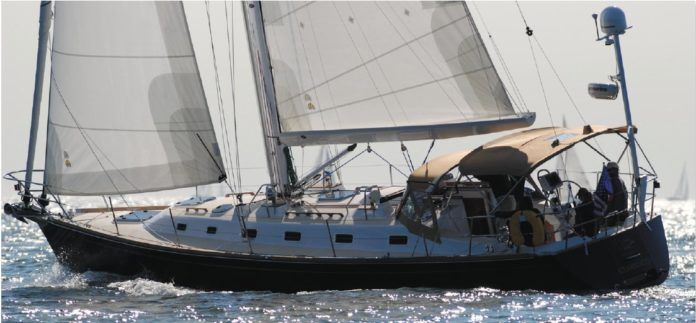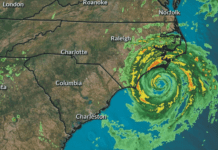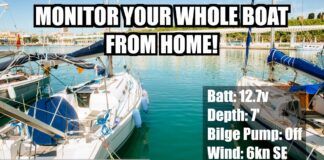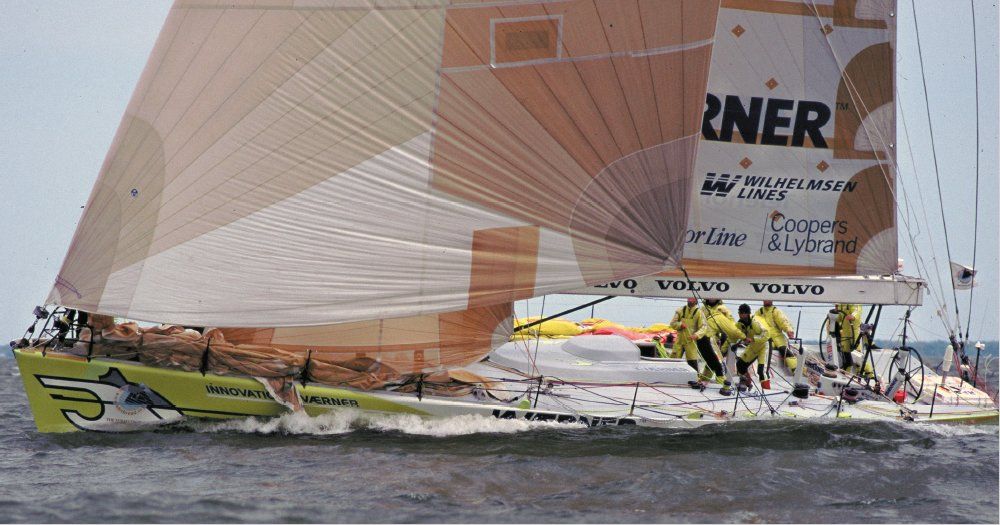
Photos by Ralph Naranjo
When it comes to sailboats, performance is a relative term, especially when it comes to a crews concept of how the boat will be used. Racing sailors, cruisers, and daysailors each have very different perspectives on performance. For example, those facing a light-air, around-the-buoys race measure performance in terms of how well their speed through the water holds up against the decrease in true-wind speed. Cruisers, on the other hand, especially those crossing oceans, often define it as a measure of versatility under sail, not just how a boat copes with near calms or gales, but how it performs in everything in between.
Ancillary factors such as directional stability, vessel motion, and heeling angle affect the outcome and get lumped into the catch-all label of performance. When scooting down the face of large waves under reduced canvas, steering characteristics and the ability of an autopilot or windvane steering system become part of the performance equation. In fact, Iron Mikes steering ability often becomes the limiting variable that tells the cruising crew when its time to dial back on sail area and slow things down. So the bottom line is that performance carries different connotations, depending on the perspective of the crew and limitations of the sailboat and its equipment.
This special report on sailboat performance is the final installation in our boat design series, which launched with a look at sailboat structure in the February 2015 issue; the second report, which focused on sailboat stability, ran in the June 2015 issue.
Performance factors
In its most classic context, performance relates to the speed a sailboat can attain on various points of sail, under specific wind and sea conditions. Calculations like the sail area-to-displacement ratio, prismatic coefficient, beam to length ratio, and ballast ratio help define the physical features of a sailboat and therefore provide a baseline for comparing one sailboat with another.
Inshore sailors seeking to get around a windward/leeward or triangular racecourse are confronted with several key realities of naval architecture. On one hand, they are interested in how well a vessel can sail close-hauled, maintaining speed and minimizing leeway. Delivering such performance through a wide wind range and variety of sea states is another boat-design challenge. But going to weather is just half of the equation, and the hull shape favored by off-the-wind sailing is quite different than what makes a boat go to weather.
The upwind aspect of performance deserves a closer look, and for centuries, naval architects have been exploring ways to maximize both the ability of sailboats to sail close-hauled and their ability to resist heeling during the process.
Deep draft, a fine entry, and moderate beam have long been recognized as beneficial traits in weatherly vessels. And higher ballast ratios can be like money in the bank when it comes to preventing and recovering from a deep knockdown-perching crew on the windward rail can also minimize heel.
More esoteric solutions include torpedo-like ballast bulbs at the tip of the keel, can’ting keels, and water ballast. The complexity and vulnerability of the latter options relegate them to boats at the most extreme end of the performance spectrum. However, all of these increase righting moment, work to reduce heel, and allow more sail area to be carried.
Performance enemies
Windage, wave making, and skin drag are performance enemies. The latter is linked to excess submerged surface area and a frictional relationship with seawater that adds drag and slows down a boat. Lighter-displacement hulls with deep keels and modest sail area can also prove to be quite nimble and weatherly, especially with new rig technology that lowers weight aloft and provides inboard sheeting and mast bending, which enhance sail shaping. But these lightweights really scoot off the wind because theres less mass to accelerate, and their flatter sections and beam-carried-aft hulls are quite willing to plane.
Windward Performance
Its clear that a modern sailboats ability to sail to windward is a combination of hull shape, underwater foil development, and rig and sail technology. Sloop rigs hold an advantage due to their high-
aspect ratio, which exposes minimal sail area to turbulent flow. But what complicates the performance picture-and is a big challenge to crew and boat designers/naval architects-is the very different set of design characteristics favored in off-the-wind sailing.
For example, a wide beam carried aft and a flat bottom tend to enhance sail-carrying ability and improve a sailboats tendency to plane. Sometimes referred to as sleds, downwind-specialized designs often have more difficulty when it comes time to sail upwind. The lift-developing underbody-which is a big plus on a reach-can force the bow down during a beat to windward, causing the vessel to head more off the wind and requiring added rudder deflection to maintain the desired angle of attack. These characteristics obviously have less negative influence in off-the-wind races; but when headed around the buoys, where upwind performance plays a crucial role, such designs lose their edge. This Achilles heel is even seen in older, beamy, around-the-world race boats, which favor off-the-wind sailing. Todays races have more port calls, requiring a solo sailor to beat toward finish lines in variable weather conditions.
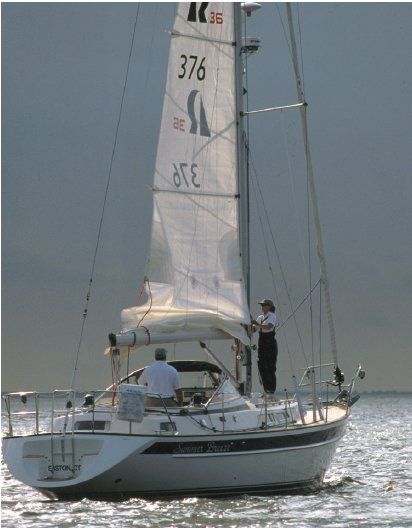
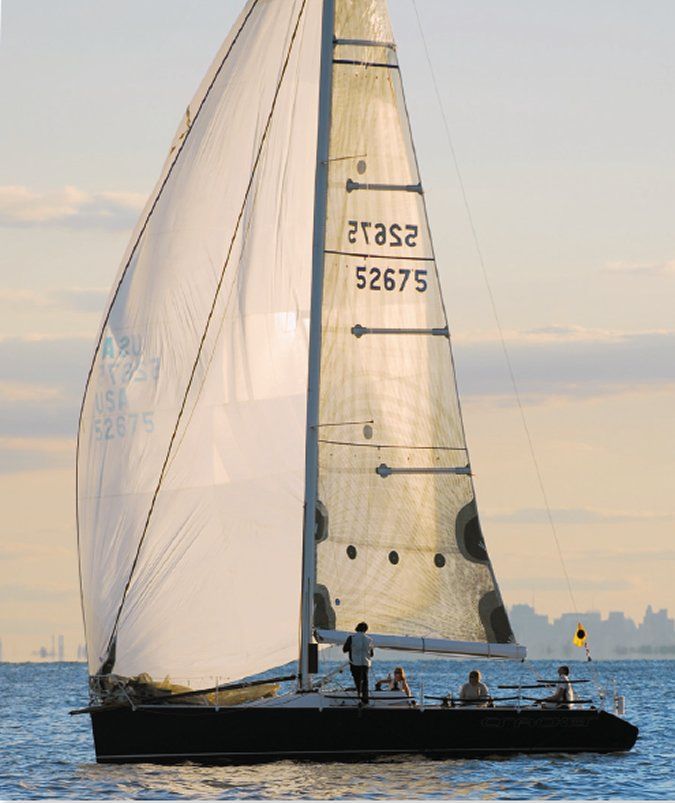
Racing Rules
For well over 100 years, yacht designers and naval architects have been dealing with racing handicap rules meant to level the playing field and allow different sized and shaped sailboats to fairly compete, even though they may finish an ocean race several days apart. Absent from auto racing, this concept is like mingling minivans and Ferraris at Le Mans-allowing a well-driven Honda Odyssey a chance to grab the silver.
Over the years, rating rules have come and gone. Some penalized length, sail area, beam, or ballast. A few have even tried to take crew competency and weather conditions into consideration. One of the biggest problems in developing fairness in a rating system is that once the parameters are known, designers are able to work their way around each obstacle, utilizing less-penalized characteristics to enhance performance. In some ways, its like a tax lawyer exploiting the loopholes.
One of the most egregious examples of rating-rule exploitation was seen in the tragic WingNuts capsize that occurred in the 2011 Chicago-Mackinac Race. (See PS April 2012 issue.) The incident underscores the way dangerous design attributes can be masked by a rating rule that fails to effectively penalize excessive beam; in the WingNuts case, this meant a boat with insufficient stability was allowed to participate in what was essentially an offshore race. The overnight, 289-nautical-mile Chicago-Mac race is held on Lake Michigan, a body of water thats known for bad squalls and rough seas.
The hull of WingNuts, a Kiwi 35, flared out dramatically where it meets the deck. Its wide deck and extreme beam at the shear line did afford a hiking platform, but much of the boats initial righting moment relied on crew weight perched on the windward rail. The same weight became a negative influence when heeling toward capsize in a strong breeze. The rating rules stability index used for the event did not properly penalize the huge difference between the Kiwi 35’s waterline beam and the deck-level beam, which led to a stability shortfall instigated by the excessively flared topsides. The rule levied a maximum penalty of 5 degrees against excess beam, regardless of how extreme the design distortion happened to be. This exaggerated deck-level beam distortion caused the vessels actual Limit of Positive Stability (LPS) to drop below 80 degrees, while its rated stability index was calculated to be 106 degrees, allowing the boat to participate in the race. (For more on boat stability, see PS June 2015.) In flat water and light-to-moderate winds, the Kiwi 35 design was effective and delivered a high level of performance. But as the wind increased and the seas built, the vessel began to heel excessively in the gust, submerging the leeward wing, which had little reserve buoyancy. Even with reduced sail, the distorted beam-to-length ratio negatively impacted the boats seaworthiness.
When it comes to sailboat design, performance must be viewed in the context of overall seaworthiness, and considered in accordance with the range of conditions the vessel is likely to encounter. This is equally important for cruising boats and racing boats, and its why most designers pay special heed to how and where a vessel will be sailed when defining its performance/seaworthiness attributes. (Check out PS February 2009 online, which looks at modern boat design, and whether quests for speed and interior comfort are trumping smart design.)
The popularity of the cruising/racing sailboat has waxed and waned over the years, and in some ways, its like the automotive industry challenge of creating sportscar-handling in an SUV-easier to achieve in ad copy than on the track. Today, there is less point-to-point club racing, and around-the-buoys weekend events are being dominated by popular one-design classes and racing sailboats with anything but a live-aboard interior.
The bottom line is that theres less emphasis on performance in whats being labeled a cruising sailboat. This is especially true when it comes to the on-the-wind performance thats missing in many mainstream production cruising sailboats. As a good friend once said, Put up enough sail area, and you can get a floating dock to sail off-the-wind, but the real art in cruising boat design is to create good all-around sailing characteristics on all points of sail.
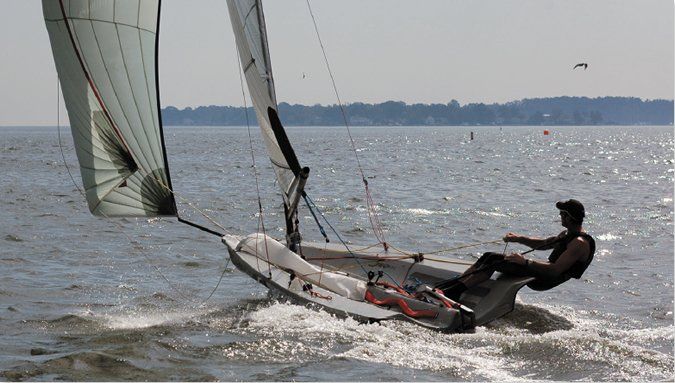
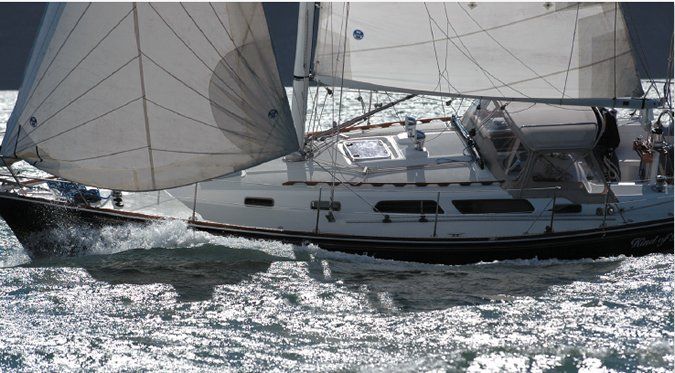
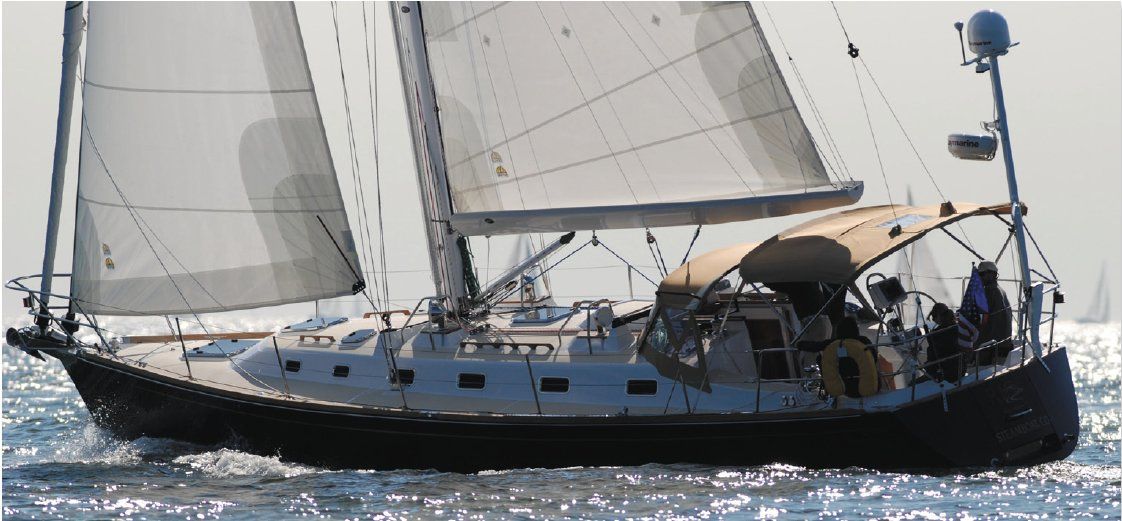
Delving into details
In our recent report on boat stability (see PS June 2015), we gave a thumbs-down for the combo of high-volume hull shapes with wide beams, shoal draft, and low ballast/displacement ratios. When such sailboats are used as offshore cruisers, they afford too little secondary righting moment and deliver an LPS thats too low (less than 110 degrees). Such designs take another hit when it comes to upwind performance. Their full, round hull shapes actually hide the short, stubby keel as the vessel heels. This all but eliminates the lateral plane effect and the lift associated with the keel foil. Leeway increases, and progress to windward is significantly diminished.
Those cruising shoal waters-and willing to do some motor sailing to augment poor windward performance-may find the accommodation volume increase afforded by these beamy, shoal-draft designs a fair trade for on-the-wind sailing performance. But when it comes to offshore passagemaking and the ability to claw off a lee shore under sail, theres no substitute for at least moderate draft and a meaningful ballast/displacement ratio (30 percent coastal and greater than 35 percent for offshore).
Cruising boat performance under sail is hinged on several inter-related factors. A few are linked to the same design criteria found in racing sailboats and mentioned earlier, but others are contingent on issues that are unique to cruising. Take for example the widespread use of an autopilot or self-steering vane-a cruising constraint with significant performance implication. Despite the fact that autopilot IQ is improving as more complex algorithms are used in the hardware, this artificial intelligence is not linked to the winches and sail trim to cope with oscillations in wind speed and direction. Consequently, an autopilot or vane compensates for changes in pressure on the sail plan with rudder deflection rather than trim changes, and some very specific boat dynamics come into play.
For example, directional stability, the tendency of a hull to maintain a course and not yaw excessively, can be very important. As a vessels speed and seaway motion increase, sailboats with less directional stability require excessive rudder response to stay on course. In a performance context, this becomes a limiting variable. Even with new autopilots, packed with better logic circuits, and able to learn the steering behavior of a vessel, theres a point where yaw outstrips steering control.
In the past, better directional stability has been linked to a longer run of keel and split rigs that allow sail area to be parceled out and balanced more efficiently. Today, larger, high-aspect ratio, semi-balanced rudders with stocks rotating on roller bearings, require less autopilot or steering vane torque, and therefore deliver more course correcting force more quickly. Even so, these contraptions are a non-seeing, non-sail trimming alternative to a helmsperson, and directional stability still remains a limiting variable when it comes to cruising-boat performance. The bottom line is that squirrelly is not a good description of steering attributes aboard a cruising boat.
Another big player in cruising-boat performance is sail area-or more specifically, the ability to dial in the right amount of sail area as quickly and easily as possible (which can be limited with a short-handed crew). Ironically, a racing sailboats sail area is often constrained by handicap formulas, while cruising boats face no such restrictions. And yet theres a universal assumption that cruising boats should have short masts, and racers get the really tall ones. Reliable diesel auxiliaries have entrenched this stereotype, as many cruisers are quick to reach for the ignition key rather than light-air headsails.
A big rig doesn’t mean you have to keep full sail set in 15-plus-knot conditions. Reefing early keeps the boat sailing flatter and steering easier, and very little speed is lost. But what lies in reserve, in the form of reefed sail area is the canvas to make 5 to 8 knots of true wind a viable sailing breeze. This is why many traditional sailboats from the no-iron-genoa era had tall rigs, lengthy bowsprits, and long booms, in order to supersize their sail area when the breeze went light.
Modern furling gear is like a photographers favorite zoom lens. It delivers the ability to cope with varying conditions and makes sail changes easier than ever. Purists argue that roller-reefed sails must be cut flatter and lack some of the drive inherent in conventionally cut sails. While this is true, its only part of the equation; you can make up for much of the shape shortfall by always adding or reducing sail area and maximizing drive, thanks to how easy it is to let out or take in sail.
Around-the-world singlehanders have taught cruisers a good lesson. They sail with very tall rigs, and more often than not, their mainsail is reefed rather than fully hoisted. This ensures that theres some extra sail area ready to coax them through light-air stretches. In addition, most pack an arsenal of roller-furled headsails to cope with various sailing angles and wind/sea conditions. Cruising sailors don’t need copies of boats sailed by these iron men and women of the roaring forties, but we need to recognize that a big rig with furling/reefing versatility can significantly increase efficiency under sail in lighter winds.
Lastly, in our cruisers performance perspective, we need to think of payload and the influence that extra water, fuel, provisions, anchors, and gear have on our boats ability to slip through the water. The really diabolical effect all these cruising essentials have on performance plays out in elevated skin drag, wavemaking, and decreases in freeboard. Teamed up, these performance parasites can add days to an ocean crossing.
Multihull sailors are most vulnerable, because their boats lean, long hulls submerge more per pound as payload soars. The resulting drag increase is significant, and as the bridgedeck grows closer to the loaded waterline, the number and severity of wave slams increase, further impacting performance and comfort aboard. The answer here is to heed the designers calculation of maximum payload, and do a serious audit of your cruising essentials. Make sure that the payload statistic is based upon fuel and water tanks being at topped off capacity.
The Power Play
Many cruisers reconcile light-air performance with gallon-per-hour fuel statistics, and as long as the machinery and tankage are up to the task, its a perfectly viable approach-especially if you don’t mind the combustion rumble and the fumes linked to mechanical propulsion.
Little things like picking an efficient cruising speed can be a big deal, especially when it comes to efficiently motoring long distances. Optimizing performance involves matching the sweet spot defined by the hull dimensions and wave-making characteristics of a given hull shape with the prop and torque curve of the engine. The best compromise among fuel efficiency, speed, drag, and wavemaking is usually found around 75 percent of hull speed. A props diameter and pitch should be set to deliver the manufacturer-specified, full-throttle RPM with a cruising payload on board. Setting pitch to increase speed at lower RPM can cause overheating, incomplete combustion, and serious engine damage.
Inshore sailors may define performance under power as maximum speed rather that maximum miles per gallon. They have many more opportunities to fill the tank and may want to shorten the time it takes to get from point to point rather than stretch the fuel for the maximum number of miles. To answer the performance quest of fast-under-power sailors, prop pitch and diameter should be set to deliver more thrust at the higher end of the RPM range. Naturally, fuel consumption will increase dramatically and wave making also will increase as the boat attempts to outwit the constraints of a displacement hull shape.
The concept of performance is a bit of a moving target thats based on the vantage point of each sailor. Racers have a very defined set of goals while a cruisers requirements are usually more multifaceted. But when it comes to designing a fast sailboat, the variables involved have been well researched, and designers and their computers have been effectively blending the attributes.
The arcane part of the science lies in the balancing act linked to optimizing a sailboat for a specific rating rule. Add to the equation the need for an appropriate level of seaworthiness, and its clear that yacht design is all about juggling important variables, and performance is only one of several key attributes.
































